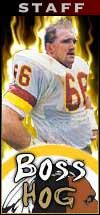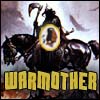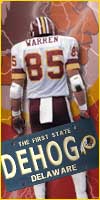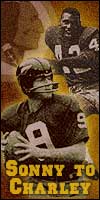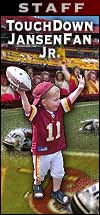What the Heck is an H-Back?
-
Skinsfan55
- +++++++++
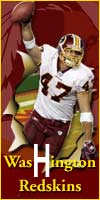
- Posts: 5227
- youtube meble na wymiar Warszawa
- Joined: Wed Feb 04, 2004 12:21 pm
- Contact:
What the Heck is an H-Back?
I hear a lot of people talking about Joe Gibbs liking to use an "H-Back"
What exactly is that?
I get the impression that it's a type of hybrid TE/FB how would this player be used in a game?
(Seems to me if it IS a half TE, half FB then Mike Sellers is the perfect canidate...)
What exactly is that?
I get the impression that it's a type of hybrid TE/FB how would this player be used in a game?
(Seems to me if it IS a half TE, half FB then Mike Sellers is the perfect canidate...)
-
Skinsfan55
- +++++++++

- Posts: 5227
- Joined: Wed Feb 04, 2004 12:21 pm
- Contact:
-
skinsfaninroanoke
- sfir

- Posts: 3476
- Joined: Mon Aug 18, 2003 1:43 am
- Location: Roanoke, VA (The sw VA heart of the Skins)
- Contact:
What some people refer to as an H-back in my mind is a tight end type player that lines up as a fullback giving you that beef in the backfield - seems to me if I remember rightly - we saw it a lot in the heavy jumbo package...
Rich in Roanoke
_______________________________________
Let others hail the rising sun:
I bow to that whose course is run
_______________________________________
Let others hail the rising sun:
I bow to that whose course is run
Re: What the Heck is an H-Back?
Skinsfan55 wrote:I hear a lot of people talking about Joe Gibbs liking to use an "H-Back"
What exactly is that?
I get the impression that it's a type of hybrid TE/FB how would this player be used in a game?
(Seems to me if it IS a half TE, half FB then Mike Sellers is the perfect canidate...)
Your right in that the H-Back is a hybrid TE/FB he can lead running plays like a FB, line up in the slot, line up as a TE, or often is the motion man for the offense to get a running start to go out for passes or get to a linebacker on running plays.
"I never apologize. I'm sorry but that's just the way I am."
-
skinsfaninroanoke
- sfir

- Posts: 3476
- Joined: Mon Aug 18, 2003 1:43 am
- Location: Roanoke, VA (The sw VA heart of the Skins)
- Contact:
although it DID use to refer to the halfback... I think the meaning has changed over the years...
Frank Wycheck was the prototypical H Back for Tennessee - came out of the fullback spot and the tight end spot depending on the formation
Frank Wycheck was the prototypical H Back for Tennessee - came out of the fullback spot and the tight end spot depending on the formation
Rich in Roanoke
_______________________________________
Let others hail the rising sun:
I bow to that whose course is run
_______________________________________
Let others hail the rising sun:
I bow to that whose course is run
Man, I just don't think that's what an h-back is anymore.
Totally agree that it used to be, but now it's just become another synonym for a running back, and more often than not, the backs they are referring to are definitely not your late 80's prototypical hybrid back.
I think that's where the confusion comes in. Like all vernacular, overuse has broadened it's meaning and lessened it's descriptiveness.
Donnie Warren
Totally agree that it used to be, but now it's just become another synonym for a running back, and more often than not, the backs they are referring to are definitely not your late 80's prototypical hybrid back.
I think that's where the confusion comes in. Like all vernacular, overuse has broadened it's meaning and lessened it's descriptiveness.

Donnie Warren

Sean Taylor was one of a kind, may he rest in peace.
-
skinsfaninroanoke
- sfir

- Posts: 3476
- Joined: Mon Aug 18, 2003 1:43 am
- Location: Roanoke, VA (The sw VA heart of the Skins)
- Contact:
An H-back is a pass-catching TE. The position is named after Dan Henning, who was offensive co-ordinator (or "assistant head coach / offense") in the early Gibbs days, left for a year or two at Atlanta, and returned before SB 22. Now with Carolina, I think.
Henning and Gibbs had a two-back standard NFL set, with Joe Washington and John Riggins. Little Joe was small, fast, shifty, a good receiver, and a pathetic blocker. Riggins was big, strong, fast (no, I'm not kidding), good blocker, and among the worst receivers ever. Hands of stone.
Gibbs and Hennings considered it, and decided that they were losing production when they had Washington block for Riggins. They decided to play a second TE, on the grounds that a TE catches passes better than a FB, and blocks better than a halfback.
Riggins became the main running back, and Washington replaced him whenever Gibbs wanted to an extra fast receiver (ah..."rocket screen" I think it was called) or wanted just to shift gears.
I think Rick Walker was the first H-back. Think of Walker lining up on the left, going in motion to the right, turning, going left, and leading John Riggins off-tackle. Now imagine Washington leading that play (even if he had not been limited in SB 17 by a knee injury).
Afterward, the position stuck. George Rogers replaced Riggins, and Kelvin Bryant replaced Washington, but Clint Didier became the model/template for the H-back.
When Gibbs ran the three-wide-receiver set (was it called "Posse"?) he used Art Monk as H-back. Monk was big for a wide-receiver, and he could block, so running The Posse was not an admission that the Redskins would be throwing.
McCants looks like the Monk-filler in the three-wides.
I doubt that any of the fullbacks will become H-backs...
Henning and Gibbs had a two-back standard NFL set, with Joe Washington and John Riggins. Little Joe was small, fast, shifty, a good receiver, and a pathetic blocker. Riggins was big, strong, fast (no, I'm not kidding), good blocker, and among the worst receivers ever. Hands of stone.
Gibbs and Hennings considered it, and decided that they were losing production when they had Washington block for Riggins. They decided to play a second TE, on the grounds that a TE catches passes better than a FB, and blocks better than a halfback.
Riggins became the main running back, and Washington replaced him whenever Gibbs wanted to an extra fast receiver (ah..."rocket screen" I think it was called) or wanted just to shift gears.
I think Rick Walker was the first H-back. Think of Walker lining up on the left, going in motion to the right, turning, going left, and leading John Riggins off-tackle. Now imagine Washington leading that play (even if he had not been limited in SB 17 by a knee injury).
Afterward, the position stuck. George Rogers replaced Riggins, and Kelvin Bryant replaced Washington, but Clint Didier became the model/template for the H-back.
When Gibbs ran the three-wide-receiver set (was it called "Posse"?) he used Art Monk as H-back. Monk was big for a wide-receiver, and he could block, so running The Posse was not an admission that the Redskins would be throwing.
McCants looks like the Monk-filler in the three-wides.
I doubt that any of the fullbacks will become H-backs...
-
skinsfaninroanoke
- sfir

- Posts: 3476
- Joined: Mon Aug 18, 2003 1:43 am
- Location: Roanoke, VA (The sw VA heart of the Skins)
- Contact:
- patrickg68
- piggie
- Posts: 161
- Joined: Sat Mar 13, 2004 11:56 am
- Location: Tampa, FL
As some of you have already stated, an H back is a tightend/fullback. I think that the reason some of you may have gotten the impression that an H back is a running back is that some systems (notably the west coast offense) use the letter H to denote the halfback. It also uses F to denote the fullback, and U to denote the second tightend. The terminology for the singleback offense that Joe Gibbs runs I believe uses F to denote the running back and H to denote the fullback/second tightend.
-
skin_to_the_bone
- Hog
- Posts: 702
- Joined: Thu Mar 11, 2004 1:53 am
- Location: Susquehanna,PA
- Contact:
Sam Ward wrote:An H-Back in a Gibbs style office is a blocking/pass catching fullback/tightend that can recognize the defensive formation and make necessary adjustments at the point of attack.
That was the best discription and quick to the point as well. Good Job Sam.
I have travelled the net and found the Redskins promise land. This is, by far, the best site out there for Redskins/NFL News, Notes, Opinions, and so much more.
----Steve
----Steve
- patrickg68
- piggie
- Posts: 161
- Joined: Sat Mar 13, 2004 11:56 am
- Location: Tampa, FL
If for example it's a running play the H-back must determine if He has to double team DE or kick out a LB or Saftey dependding on defensive line-up, if it's a pass He either goes out for a pass or may have to stay in and block if He reads blitz.
"I never apologize. I'm sorry but that's just the way I am."
-
Steve Spurrier III
- ----------
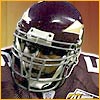
- Posts: 2167
- Joined: Sat Jan 17, 2004 1:48 am
-
RedskinsFreak
- -------
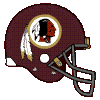
- Posts: 2947
- Joined: Thu Jul 03, 2003 2:41 pm
- Location: Lanham, MD
... or Clint Didier.Steve Spurrier III wrote:The reason people are thinking that the term H-back means something different now is because few teams still use an H-back.
When you think H-back, think Frank Wycheck..
What I remember about the H-back having options would be when he released from the line on a pattern, he read what the LB and safety were doing in coverage -- and then had to option to take the route up the hash marks or to cut it off to a hook or an out.
Oh, and DEHog, Don Warren was everything BUT an H-back.
***** Hail To The Redskins!!! *****
BA + MS = A New Beginning
BA + MS = A New Beginning
JOE GIBBS OFFENSIVE THEORY (1983)
The easiest approach – and the logical one – is to think of the set-up as you would the “I”. But, now you have the “I” fullback up near the L.O.S. on either side, and he is called the “H” (HYBRID) back.
X------------O-O-C-O-O-0
----------H-------Q-------------------Z
------------------R
X-------------O-O-C-O-O-O
--------------------Q-----------H-------Z
--------------------R
Much of your motion comes from moving your “H” from one side to the other. The movement creates problems for the defense in that they must determine how to support the corner of the defense and at the same time account for coverage on each receiver.
By being close to the L.O.S., the “H” back has a higher percentage block than your ordinary “I” fullback would have. At the same time, the “H” position allows a quicker release if he is to be a receiver. Of course, he is not the running threat that your “I” fullback would present, but most “I” teams do not run the fullback as a feature anyway. In addition, you do not have the versatility (of having strength to either side on the snap) that you have in the “I”. However, the position close to the L.O.S. does compensate for all of this by being a more effective blocker and receiver as a “H” back (and forces the defense to protect an extra gap). And with the created defensive problems (with movement) as an “H”, it more than compensates for the reduced element of surprise. We use our “Counter-Gap” play to keep the defense honest and not over-compensate for the position of the “H” back. A very effective play.
JOE GIBBS OFFENSIVE THEORY (ARTICLE FOLLOWING SUPER BOWL/1983)
The One-Back concept fits our personnel very well. If we played two backs simultaneously, one would have to do the blocking for the other. When Riggins carried, Joe Washington, who weighs only 180 pounds, would have to block for him. We would rather have one of those backs sitting on the bench resting and have a 250 pound tight end blocking for us.
Second, our offense is better suited to the widespread use of the 3-4 defense. We had nine 3-4 teams to play. These teams have dominating outside linebackers who have taken over the game. When we play the Giants, they have Brad VanPelt and Lawrence Taylor on the outside. If you try to block Taylor with a back, you’re going to lose. It’s impossible, so it’s better to have two tight ends. Then Lawrence Taylor has to rush around a 250 pound blocker if he wants to get into our backfield. That’s a whole different story. With four good receivers, we can also threaten downfield with four men off the line of scrimmage.
NOTE: In 1983, the Redskins were 80-90% two tight ends, two wide receivers, and one running back (Riggins). On long yardage, they were one tight end, three wide receivers, and one running back. However, the Redskins mixed this up and use the three wide receiver lineup on first downs when the defense would probably not have a fifth defensive back in the game. Their aim is to match one wide receiver against a strong safety or a linebacker.
*************************************************************
ALSO:
H-back a priority for Gibbs
If football positions were ranked by glamour, H-back probably would fall somewhere between third-string quarterback and the guy who holds the ball on kickoffs when it gets too windy.
If those same positions were ranked by importance in Joe Gibbs' offensive scheme, H-back might be on par with quarterback.
Don't laugh. Much of Gibbs' offense is centered around this unusual, part-fullback, part-tight end role, so it should come as no surprise the Washington Redskins have made it a priority this offseason.
"That's a key position for us," offensive coordinator Don Breaux said yesterday as the Redskins' first minicamp of the year concluded. "And there aren't a lot of those guys around. We have big expectations for that, and maybe our standards are high."
So high that perhaps no other position on the field this weekend looked so deep with talent and possibilities. Washington had five H-backs or tight ends participating in minicamp in Byron Chamberlain, Mike Sellers, Walter Rasby, Robert Royal and Kevin Ware.
That list doesn't include Bryan Johnson, who had his $4.3 million offer sheet matched by the Redskins on Friday. Johnson, however, may not fit into the equation much longer. Washington is expected to trade the fourth-year fullback to the Chicago Bears today, sources familiar with the likely deal said last night.
Whether the Johnson deal goes through, Gibbs still may not be done looking for H-backs. One of the prime targets for Washington's first-round pick in next month's draft (No. 5 overall) is Miami tight end Kellen Winslow Jr., a dynamic pass catcher who club sources believe would fit in perfectly as an H-back.
Put them all together and Washington's coaching staff should have no shortage of capable H-backs and tight ends to choose from come training camp this summer.
"Some of them are going to separate themselves from the rest," Breaux said. "There's going to be some real competition."
Why such importance on a seemingly inconsequential position? The answer lies in the fact Gibbs and his assistants feel the position is anything but inconsequential.
Unlike Steve Spurrier's Fun 'n' Gun offense, in which tight ends and fullbacks were often benched in favor of a third or fourth wide receiver, Gibbs' system places a premium on these positions.
"It's like night and day," Chamberlain said when comparing last year's offense to this year's. "[Gibbs'] system is definitely going to utilize our tight ends and our H-backs. We're going to be an integral part of the offense."
Gibbs uses the tight end almost exclusively as an extra blocker on the offensive line, a role that seems to fit both Rasby and Royal. The H-back, meanwhile, is asked to do any number of things from any number of locations on the field.
"He's got to be a blocker, he's got to be a pass protector and he's got to be able to run routes," Breaux said. "It's a unique position, really."
The H-back can line up in the backfield, on the line or -- as is often the case -- is put into motion. On one play, he may be asked to serve as lead blocker for tailback Clinton Portis. The next, he may be sprinting 15 yards downfield to catch a pass.
"That's a tough position to play," assistant head coach for offense Joe Bugel said. "You have to be super, super smart, and you have to have some athletic ability."
The Redskins believe they have several players who fit that mold in Chamberlain, Sellers and Ware, and they likely would use Winslow Jr. there if they select him in the draft. Both Chamberlain and Sellers have excelled as H-backs, though each comes with question marks.
A former Pro Bowl tight end with the Minnesota Vikings, Chamberlain was a bust of a midseason acquisition last year. He appeared in only four games, caught just four passes for 29 yards and had conditioning issues.
The 32-year-old would seem to have a golden opportunity to reinvigorate his career in Gibbs' system, but he disappointed several observers at minicamp this weekend when he showed up well over his listed playing weight of 250 pounds.
"There's a long way to go before [training] camp," Chamberlain said. "Right now, I'm in just as good of shape as anybody out here."
Sellers, meanwhile, returns to the Redskins after an unsuccessful stint with the Cleveland Browns (where he faced drug charges) and two seasons with the Winnipeg Blue Bombers of the CFL. Once a valued lead blocker for Stephen Davis, the 28-year-old hopes to get his career back on track with his old team.
"It's a perfect fit for me," Sellers said. "I wouldn't accept anything less than to get back to where I was before. I left [Washington] as a starter. I want to come back as a starter."
Whoever ends up winning the H-back job will find himself playing a key role in Gibbs' offense. Even if it comes without any glamour.
"It's totally different from any other position because you have to know pretty much every other position on the field," Sellers said. "You can line up at any position at any given time and be asked to run whatever they want to run. In a sense, you have to know as much as the quarterback."
The easiest approach – and the logical one – is to think of the set-up as you would the “I”. But, now you have the “I” fullback up near the L.O.S. on either side, and he is called the “H” (HYBRID) back.
X------------O-O-C-O-O-0
----------H-------Q-------------------Z
------------------R
X-------------O-O-C-O-O-O
--------------------Q-----------H-------Z
--------------------R
Much of your motion comes from moving your “H” from one side to the other. The movement creates problems for the defense in that they must determine how to support the corner of the defense and at the same time account for coverage on each receiver.
By being close to the L.O.S., the “H” back has a higher percentage block than your ordinary “I” fullback would have. At the same time, the “H” position allows a quicker release if he is to be a receiver. Of course, he is not the running threat that your “I” fullback would present, but most “I” teams do not run the fullback as a feature anyway. In addition, you do not have the versatility (of having strength to either side on the snap) that you have in the “I”. However, the position close to the L.O.S. does compensate for all of this by being a more effective blocker and receiver as a “H” back (and forces the defense to protect an extra gap). And with the created defensive problems (with movement) as an “H”, it more than compensates for the reduced element of surprise. We use our “Counter-Gap” play to keep the defense honest and not over-compensate for the position of the “H” back. A very effective play.
JOE GIBBS OFFENSIVE THEORY (ARTICLE FOLLOWING SUPER BOWL/1983)
The One-Back concept fits our personnel very well. If we played two backs simultaneously, one would have to do the blocking for the other. When Riggins carried, Joe Washington, who weighs only 180 pounds, would have to block for him. We would rather have one of those backs sitting on the bench resting and have a 250 pound tight end blocking for us.
Second, our offense is better suited to the widespread use of the 3-4 defense. We had nine 3-4 teams to play. These teams have dominating outside linebackers who have taken over the game. When we play the Giants, they have Brad VanPelt and Lawrence Taylor on the outside. If you try to block Taylor with a back, you’re going to lose. It’s impossible, so it’s better to have two tight ends. Then Lawrence Taylor has to rush around a 250 pound blocker if he wants to get into our backfield. That’s a whole different story. With four good receivers, we can also threaten downfield with four men off the line of scrimmage.
NOTE: In 1983, the Redskins were 80-90% two tight ends, two wide receivers, and one running back (Riggins). On long yardage, they were one tight end, three wide receivers, and one running back. However, the Redskins mixed this up and use the three wide receiver lineup on first downs when the defense would probably not have a fifth defensive back in the game. Their aim is to match one wide receiver against a strong safety or a linebacker.
*************************************************************
ALSO:
H-back a priority for Gibbs
If football positions were ranked by glamour, H-back probably would fall somewhere between third-string quarterback and the guy who holds the ball on kickoffs when it gets too windy.
If those same positions were ranked by importance in Joe Gibbs' offensive scheme, H-back might be on par with quarterback.
Don't laugh. Much of Gibbs' offense is centered around this unusual, part-fullback, part-tight end role, so it should come as no surprise the Washington Redskins have made it a priority this offseason.
"That's a key position for us," offensive coordinator Don Breaux said yesterday as the Redskins' first minicamp of the year concluded. "And there aren't a lot of those guys around. We have big expectations for that, and maybe our standards are high."
So high that perhaps no other position on the field this weekend looked so deep with talent and possibilities. Washington had five H-backs or tight ends participating in minicamp in Byron Chamberlain, Mike Sellers, Walter Rasby, Robert Royal and Kevin Ware.
That list doesn't include Bryan Johnson, who had his $4.3 million offer sheet matched by the Redskins on Friday. Johnson, however, may not fit into the equation much longer. Washington is expected to trade the fourth-year fullback to the Chicago Bears today, sources familiar with the likely deal said last night.
Whether the Johnson deal goes through, Gibbs still may not be done looking for H-backs. One of the prime targets for Washington's first-round pick in next month's draft (No. 5 overall) is Miami tight end Kellen Winslow Jr., a dynamic pass catcher who club sources believe would fit in perfectly as an H-back.
Put them all together and Washington's coaching staff should have no shortage of capable H-backs and tight ends to choose from come training camp this summer.
"Some of them are going to separate themselves from the rest," Breaux said. "There's going to be some real competition."
Why such importance on a seemingly inconsequential position? The answer lies in the fact Gibbs and his assistants feel the position is anything but inconsequential.
Unlike Steve Spurrier's Fun 'n' Gun offense, in which tight ends and fullbacks were often benched in favor of a third or fourth wide receiver, Gibbs' system places a premium on these positions.
"It's like night and day," Chamberlain said when comparing last year's offense to this year's. "[Gibbs'] system is definitely going to utilize our tight ends and our H-backs. We're going to be an integral part of the offense."
Gibbs uses the tight end almost exclusively as an extra blocker on the offensive line, a role that seems to fit both Rasby and Royal. The H-back, meanwhile, is asked to do any number of things from any number of locations on the field.
"He's got to be a blocker, he's got to be a pass protector and he's got to be able to run routes," Breaux said. "It's a unique position, really."
The H-back can line up in the backfield, on the line or -- as is often the case -- is put into motion. On one play, he may be asked to serve as lead blocker for tailback Clinton Portis. The next, he may be sprinting 15 yards downfield to catch a pass.
"That's a tough position to play," assistant head coach for offense Joe Bugel said. "You have to be super, super smart, and you have to have some athletic ability."
The Redskins believe they have several players who fit that mold in Chamberlain, Sellers and Ware, and they likely would use Winslow Jr. there if they select him in the draft. Both Chamberlain and Sellers have excelled as H-backs, though each comes with question marks.
A former Pro Bowl tight end with the Minnesota Vikings, Chamberlain was a bust of a midseason acquisition last year. He appeared in only four games, caught just four passes for 29 yards and had conditioning issues.
The 32-year-old would seem to have a golden opportunity to reinvigorate his career in Gibbs' system, but he disappointed several observers at minicamp this weekend when he showed up well over his listed playing weight of 250 pounds.
"There's a long way to go before [training] camp," Chamberlain said. "Right now, I'm in just as good of shape as anybody out here."
Sellers, meanwhile, returns to the Redskins after an unsuccessful stint with the Cleveland Browns (where he faced drug charges) and two seasons with the Winnipeg Blue Bombers of the CFL. Once a valued lead blocker for Stephen Davis, the 28-year-old hopes to get his career back on track with his old team.
"It's a perfect fit for me," Sellers said. "I wouldn't accept anything less than to get back to where I was before. I left [Washington] as a starter. I want to come back as a starter."
Whoever ends up winning the H-back job will find himself playing a key role in Gibbs' offense. Even if it comes without any glamour.
"It's totally different from any other position because you have to know pretty much every other position on the field," Sellers said. "You can line up at any position at any given time and be asked to run whatever they want to run. In a sense, you have to know as much as the quarterback."
